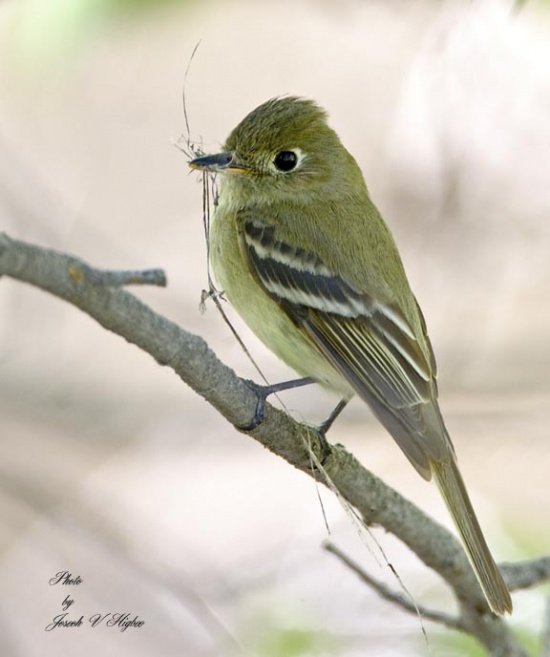Nomdeploom (talk | contribs) (add similar species section) |
(taxonomy, refs) |
||
| Line 15: | Line 15: | ||
The Pacific-slope Flycatcher was formerly considered conspecific with the [[Cordilleran Flycatcher]] under the name Western Flycatcher. | The Pacific-slope Flycatcher was formerly considered conspecific with the [[Cordilleran Flycatcher]] under the name Western Flycatcher. | ||
| + | Three subspecies are recognized: | ||
| + | *''E. d. difficilis'' | ||
| + | *''E. d. insulicola'' | ||
| + | *''E. d. cineritius'' | ||
| + | |||
| + | The form ''E. d. insulicola'' which is breeding on the Channel Islands off [[California]] are isolated and may deserve status as a full species. | ||
==Habitat== | ==Habitat== | ||
Preferred habitats include moist, shaded coniferous or mixed forests. | Preferred habitats include moist, shaded coniferous or mixed forests. | ||
| Line 22: | Line 28: | ||
Nests can be made in tree stumps and upturned tree roots. The female builds the nest of moss, grass, rootlets, bark, and lichen, and lines it with hair and feathers. 3-4 eggs are laid and incubated for 14 to 15 days. Both parents feed the young, which leave the nest at about 15 days. The young stay near the nest for a few days after fledging. | Nests can be made in tree stumps and upturned tree roots. The female builds the nest of moss, grass, rootlets, bark, and lichen, and lines it with hair and feathers. 3-4 eggs are laid and incubated for 14 to 15 days. Both parents feed the young, which leave the nest at about 15 days. The young stay near the nest for a few days after fledging. | ||
| − | + | ==References== | |
| + | #{{Ref-Clements6thDec10}}#BNA online (Cornell Lab of Ornithology) | ||
==External Links== | ==External Links== | ||
{{GSearch|Empidonax+difficilis}} | {{GSearch|Empidonax+difficilis}} | ||
[[Category:Birds]] [[Category:Empidonax]] | [[Category:Birds]] [[Category:Empidonax]] | ||
Revision as of 14:12, 4 April 2011
- Empidonax difficilis
Identification
Length: 12.75cm (5in). Head is triangular in shape with a white eye ring, lower mandible is orange, upperparts are brown-olive, olive breast, yellow throat, belly and undertail coverts, 2 white-yellow wing bars. It is very difficult to distinguish from the Cordilleran Flycatcher (Empidonax occidentalis) in the field, except by the call of the male. In winter, both species migrate south to Mexico, where they are virtually indistinguishable from one another.
Similar Species
- Cordilleran Flycatcher: physically indistinguishable except by voice in the males. Location is the best determinate.
- Yellow-bellied Flycatcher: has shorter tail than E. difficilis, and brighter, more yellow wing bars.
Distribution
Western North America as far north as British Columbia. Breeds from Alaska south along the coast to Baja California. Spends winters in the lowlands of western Mexico.
Taxonomy
The Pacific-slope Flycatcher was formerly considered conspecific with the Cordilleran Flycatcher under the name Western Flycatcher.
Three subspecies are recognized:
- E. d. difficilis
- E. d. insulicola
- E. d. cineritius
The form E. d. insulicola which is breeding on the Channel Islands off California are isolated and may deserve status as a full species.
Habitat
Preferred habitats include moist, shaded coniferous or mixed forests.
Behaviour
Prey is caught in the air, or from foliage. The diet is mainly flying or crawling insects.
Nests can be made in tree stumps and upturned tree roots. The female builds the nest of moss, grass, rootlets, bark, and lichen, and lines it with hair and feathers. 3-4 eggs are laid and incubated for 14 to 15 days. Both parents feed the young, which leave the nest at about 15 days. The young stay near the nest for a few days after fledging.
References
- Clements, JF. 2010. The Clements Checklist of Birds of the World. 6th ed., with updates to December 2010. Ithaca: Cornell Univ. Press. ISBN 978-0801445019. Spreadsheet available at http://www.birds.cornell.edu/clementschecklist/Clements%206.5.xls/view
- BNA online (Cornell Lab of Ornithology)




